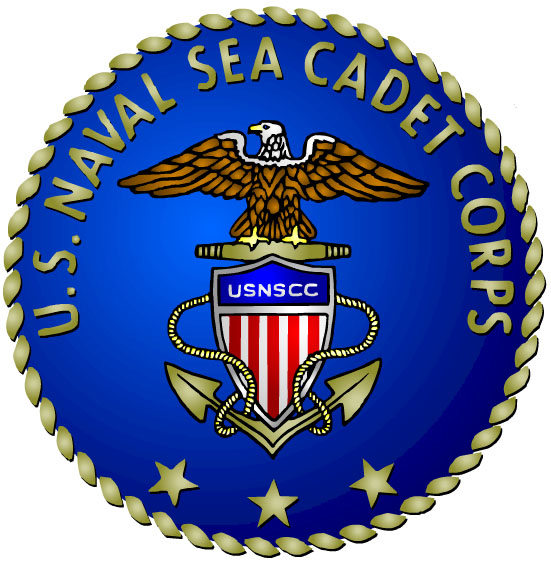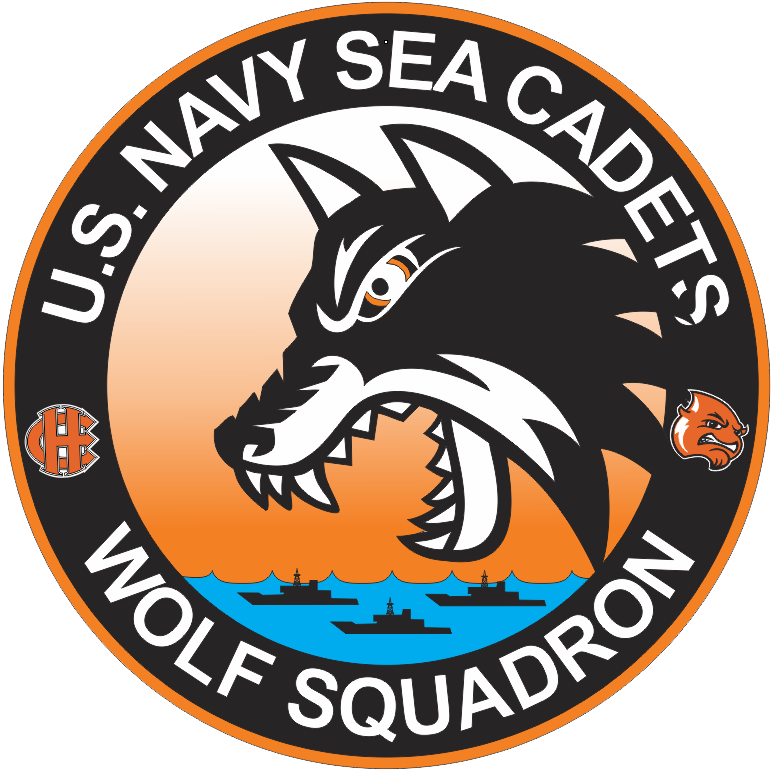In order for cadets to move up through the ranks they must complete the following: the NRTC Correspondence Course for that rate, one training evolution, and depending on the rate, the Navy's Military Leadership exam for that rate. NRTC's cover basic military and naval subjects such as naval history, seamanship, leadership, and ship/aircraft familiarization. The cadet rate structure parallels that of the Navy and Coast Guard's enlisted rate structure, with Chief Petty Officer being the highest rate a cadet can achieve.
Training takes place mostly during summer months and occasionally during winter and spring break periods and are generally one to two week evolutions. The first training evolution for all cadets is NSCC Recruit Training, better known as boot camp. It is a scaled down version of the Navy's boot camp. For approximately two-weeks cadets are instructed by active and reserve military personnel and Sea Cadet officers in military drill and discipline, physical fitness, seamanship, shipboard safety, first aid, naval history, and leadership.
Attached is a listing of
the Advanced Training courses offered nationwide during the Summer
of 2023.
You can get more specific information about training modules below.
Sample of Advanced Training Course Offerings
|

|
RECRUIT TRAINING & BEYOND
|
|
Recruit Training (RT) is the first training a Cadet attends. This is an
age appropriate "Basic Training / Boot Camp" meant to instruct Cadets in
what it means and takes to be a US Naval Sea Cadet. Cadets must first
complete RT before they can participate in other Advanced Trainings. Sea
Cadet training is held throughout the continental United States, Hawaii,
Puerto Rico and Guam on military installations and group training
facilities. Below are some of the Sea Cadet advanced trainings offered
throughout the calendar year.
|
|
|

|
AIRMAN/FLIGHT TRAINING
|
|
Sea cadets can learn various aspects of aviation including aircraft
flight controls, mechanical maintenance, flight planning and many other
aspects of aviation including Naval aircraft history and they types of
fixed wing and rotary winged aircraft used in Naval aviation and their
purpose. Cadets in advanced airman training may also have the
opportunity to receive actual flight time as part of their training.
|
|
|

|
FLIGHT SYSTEMS AND AIR TRAFFIC/GROUND CONTROL
|
|
Sea cadets will get to experience the air traffic control and ground
operations side of aviation as they will get to train in the processes
and procedures in coordinating flight plans and flight traffic,
maintaining communications with pilots, assessing and communicating
weather conditions and the overall operations maintaining safe runway
conditions for landing and take off of aircraft.
|
|
|

|
CULINARY TRAINING
|
|
In this training, cadets will get to experience the tasks of menu
planning and food preparation for large groups, typically preparing
meals for their shipmates attending other training's running under the
same training contingent. Cadets will be trained in proper safety galley
procedures in regards to fire, hot surfaces and sharp utensils as well
as safe food handling procedures..
|
|
|

|
MEDICAL TRAINING
|
|
Sea Cadets will get to experience a variety of medical themed
training's. These training's may include general medical such as first
responder / first aid type training, Military Field Ops / Corpsman
training as well as advanced specialized training's for surgical, dental
technician, CPR and other specialized training's. During these
training's, cadets will receive instruction by medical professionals in
their field.
|
|
|

|
FIRE FIGHTER / DAMAGE CONTROL TRAINING
|
|
Cadets will be trained in all aspects of firefighting and damage
control. This includes types of fire and extinguishing agents, proper
fire fighting techniques, fire fighting tools and equipment as well as
shipboard emergency procedure pertaining to damage control such as ship
procedures for breached/flooded compartments and emergency repair
procedures to hull breaches and shipboard water/bilge systems.
|
|
|

|
PHOTO JOURNALISM TRAINING
|
|
In this training cadets will be trained in photo journalism and digital
media concepts similar to combat correspondents in the military. These
cadets are also sometimes tasked with updating social media pages for
training contingents during the course of other training's falling under
the same contingent command. These cadets learn creative writing skills
for their articles as well as basic photography skills.
|
|
|

|
CEREMONIAL GUARD TRAINING
|
|
In this training cadets will be trained in ceremonial guard procedures
outlined in the USMC drill manual including basic honor guard detail
procedures, multiple advanced honor guard formations and procedures as
well as other ceremonial procedures for events such as rifle salutes,
rendering customs and curiosities such as side boys, piping aboard
senior officers/dignitary's, manning the rail, etc.
|
|
|

|
SHIPBOARD AND SUBMARINER TRAINING
|
|
In these training's, Sea Cadets will get to experience a variety of
training's designed to give them education and experience in seamanship
and sea going subjects. This will give them an exposure deck operations,
bridge operations as well as engineering and emergency response
responsibilities while aboard ship. Cadets will also get in-depth
instruction in marlinespike seamanship (ships lines and knot tying
procedures)
|
|
|

|
MARKSMANSHIP TRAINING
|
|
In this training, Sea Cadets will learn safe firearm handling, firearm
nomenclature and proper procedures for shooting firearms. Cadets will
usually shoot for score at these training's where they will be able to
qualify for their marksmanship ribbon with the Sharpshooter or Expert
Appurtenance. This training will sometimes be incorporated within other
training's such as Master At Arms, Sea Bee Training or Recruit Training.
|
|
|

|
SEA BEE ( CB, Construction Battalion) BASIC & ADVANCED TRAINING
|
|
In this training, Sea Cadets learn about the function of the CB (Sea
Bee) Construction Battalion in the Navy while performing different
construction jobs. They will usually focus primarily on wood frame and
earthen construction projects such as obstacle courses. During the
training, cadets learn basic construction techniques and concepts using
basic hand and powered construction tools.
|
|
|

|
MAA (Master at Arms) TRAINING BASIC & ADVANCED / JAG TRAINING
|
|
This training is designed to allow Sea Cadets to train as military law
enforcement. In this training, cadets will learn about the uniform code
of military justice, legal means of search and seizure and the legal
method of placing someone under arrest. They will also learn proper
procedures for making vehicle stops, clearing buildings and structures
and maintaining base security measures and maintaining a secure
parameter.
|
|
|

|
SCUBA TRAINING BASIC & ADVANCED
|
|
Cadet's attending this training will be working toward becoming SCUBA
certified. They will learn about the required equipment and safety
checks while working toward these certifications. These training's do
require a cadet to make a prerequisite swim qualification prior to
obtaining a billet. These training's are also prerequisites for other
training's that a cadet may want to attend later.
|
|
|

|
SAILING TRAINING BASIC & ADVANCED
|
|
Cadet's attending this training will get to experience life on the high
seas while learning how to sail their own vessel. These cadet will be
instructed on the shipboard nomenclature and safe boating practices and
procedures while learning how to plot their course on a chart and assess
sea and wind conditions to set sail to get to their destination while
having a great time and sense of accomplishment while doing it.
|
|
|

|
PETTY OFFICER LEADERSHIP ACADEMY (POLA)
|
|
All Sea Cadet's are required to attend this training before advancing to
E-5 Petty Officer 2nd Class. Cadets that attend this training learn
about leadership to prepare them for the transition from cadets to NCO's
within the cadet chain of command. During training, cadets are taught
valuable leadership and management skills to lead their shipmates while
reinforcing the Navy's creed of Honor, Courage and Commitment.
|
|
|

|
INTERNATIONAL EXCHANGE PROGAM
|
|
This training is an opportunity for Sea Cadets in the United States to
travel abroad and train for two weeks with cadets in other countries.
Foreign Exchange partnering countries include Australia, Belgium,
Bermuda, Canada, Hong Kong, Japan, Netherlands, Russia, South Korea and
the United Kingdom. Most expenses are paid for this training for the
cadets and adult officers attending but it is very exclusive and has an
application process. Only the most squared away cadets are selected for
these limited opportunities.
|
|
|
LEAGUE CADET TRAININGS

League Cadet training is a little more limited due to age, size, and
physical safety factors.
The first training League Cadets are eligible to attend is NLCC
Orientation which is designed to be a League Cadet version of Recruit
Training for Sea Cadets and provides intense training in military and
naval subjects and an introduction to the military training atmosphere.
Once NLCC Orientation is completed, NLCC are eligible to attend other
NLCC advanced trainings similar to the ones mentioned above scaled down
for their age level in a variety of subjects relevant to prepare cadets
for transition to the Sea Cadets at a later age.
On a unit level, Navy League cadets are trained in nautical skills such
as knot tying and splicing, signaling, water safety and swimming, first
aid, and even fire fighting. Cadets are instructed in military drill and
discipline and are taught from a syllabus covering naval history to ship
nomenclature. Navy League cadets also tour ships and bases and
participate in community events such as parades and fairs.
Taking part in the pride and honor of wearing the Navy uniform, and
being a part of a fine organization gives the NLCC cadet a sense of
service. In addition, NLCC cadets who complete one year in the program,
and later cross over to the Sea Cadets, will enter at a higher rate. The
training received in the NLCC will give cadets the experience for an
easy transition to the Naval Sea Cadet Corps.
|
|






















